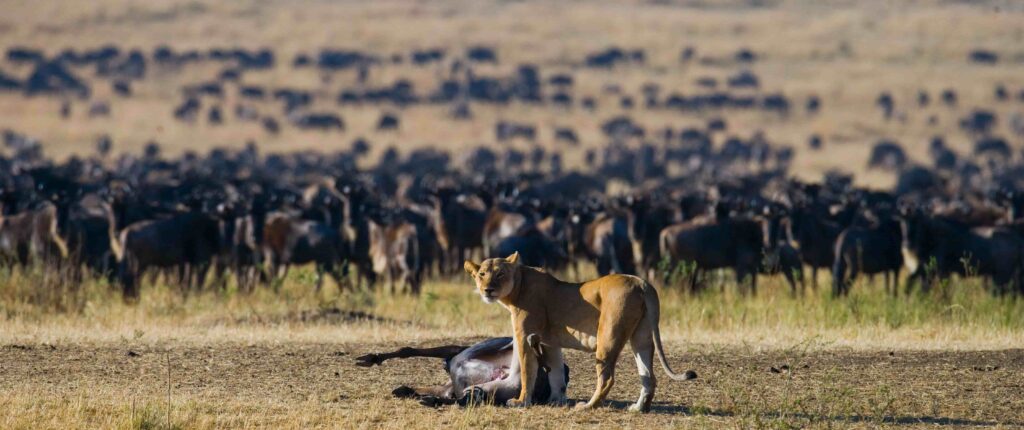The Great Migration
One of Nature's Greatest Spectacles
Imagine constantly running in pursuit of food, never spending too much time in one place while always looking over your shoulder for predators that are trying to hunt you…and navigating a rushing river that is teeming with powerful jaws and sharp teeth that want nothing more than to drown and eat you. Whew, this gets me anxious just thinking about it! This is the reality of the Great Migration and the circle of life.
The Great Migration is a continuous, non-stop, 500-mile roundtrip journey of 2.5 million wildebeest and half a million zebra over the plains of the Serengeti in Tanzania, to Kenya’s Masai Mara, across the Mara River and back again…and again…and again. These animals spend their whole lives following the rains to greener grasslands in an endless quest for food. Meanwhile, lions, crocodiles and other big cats are chomping at the bit, awaiting their arrival. Times are good for predators when the migration comes knocking.

The migration’s arrival completely transforms the safari scene. Wildebeest and zebra blanket the grasslands as far as the eye can see. Their hooves thunder as they run thousands at a time, leaving trails of dust in the air. The soundtrack is a constant, unsynchronized chorus of wildebeest bellows, and you, the audience, have a front row seat. The stage is set.

The Mara River is where some of the best action is. River crossings during the Great Migration can be very dramatic. I remember my first river crossing vividly. Thousands of wildebeest had gathered and began collectively pacing back and forth and back and forth in a huge stack along the Mara river, creating dust clouds and a lot of tension in the buildup to the climax. When were they going to make a go? It just takes one to make the jump into the river, and then they all follow. Once that happened, it was a mad dash of thundering hooves, splashing water and racing hearts! It was such an amazing sight! They funneled into the river and swam for their lives, thousands and thousands of them. As I was snapping pictures, looking through my camera’s viewfinder, I happened to land on a lion on the other side of the river. “There’s a lion! There’s a lion!” It was dragging a wildebeest away from the river’s edge and into the grass. It was an incredible sight! Of course, I felt really sad for the wildebeest, but I also had a rush of adrenaline witnessing the intensity of a hunt right before my eyes. It was an epic moment!
Anything can happen during a river crossing, and every river crossing is different. Sometimes all the wildebeest and zebra make it. Sometimes crocodiles get their dinner. Sometimes only a few animals will cross. Sometimes there are no crossings at all during a stretch of days. It is important to remember that because nature is unpredictable, sightings such as river crossings and hunts are not guaranteed. Nature is unscripted, and we don’t know what’s going to happen on any given safari so we must cherish all the sightings we are privileged and lucky enough to witness.
When to Go
Typically, the Great Migration takes place in the Masai Mara between July and October though it varies every year depending on rainfall, predator location and the free will of the wildebeest and zebra, so exact timing of the arrival of the migration and subsequent river crossings cannot be guaranteed. Again, this is nature, raw and unscripted!
